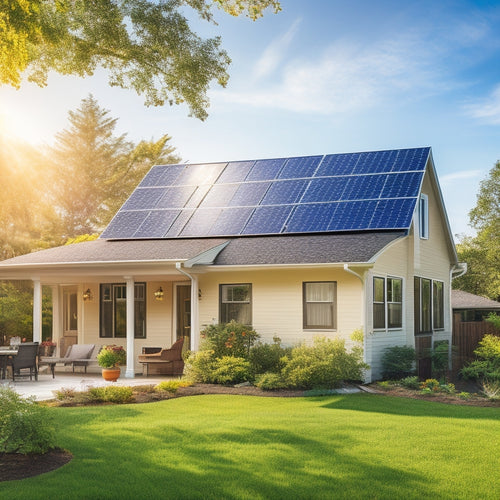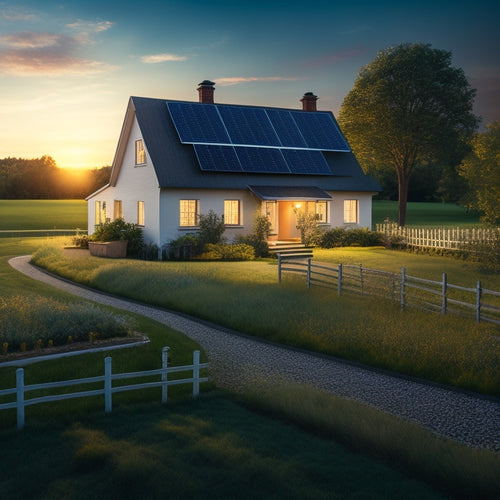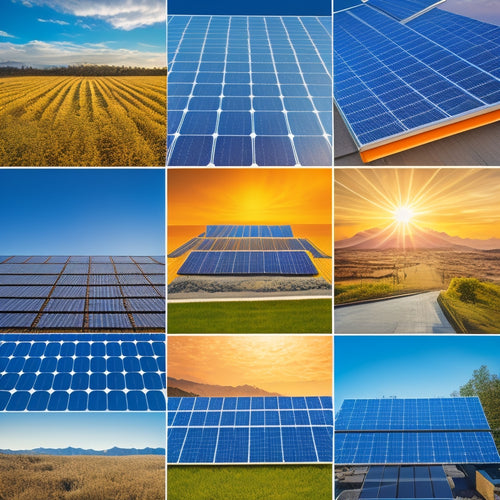
7 Essential Tips for DIY Solar Panel Installation
Share
When installing DIY solar panels, start by evaluating your energy needs through an energy audit and consumption patterns analysis. Choose a high-efficiency kit with solid user reviews and all necessary components. For site selection, conduct a shading analysis, confirm roof durability, and align panels effectively. Obtain essential permits by researching local zoning laws and submitting detailed plans. Use specific mounting systems, follow manufacturer specs, and secure panels properly. During electrical wiring, turn off power, wear protective gear, and ensure proper wire sizing and connections. Conduct system tests and schedule regular maintenance to maintain peak efficiency. Stay tuned for more insights.
Key Takeaways
- Assess your energy needs by calculating daily consumption and conducting an energy audit.
- Choose a reputable solar kit with high efficiency and positive user reviews.
- Position panels for optimal sunlight exposure, facing true south/north, and adjust seasonally.
- Secure necessary permits by researching local zoning laws and ensuring compliance with building codes.
- Regularly clean solar panels using non-abrasive tools to maintain peak efficiency.
Assess Your Energy Needs
https://www.youtube.com/watch?v=M89LDaTzgmo
Begin by calculating your household's daily energy consumption to determine the necessary capacity for your solar panel system. Conducting an energy audit is your first step. This involves examining your utility bills over the past year to identify consumption patterns. Pay attention to your kilowatt-hour (kWh) usage during different seasons and peak periods.
To execute a precise energy audit, list all your electrical devices, their wattage, and the average hours they're used daily. For instance, if your refrigerator consumes 150 watts and runs 24 hours a day, that's 3.6 kWh daily. Repeat this for all devices to get a thorough understanding of your total daily consumption.
Next, analyze your consumption patterns. Are there spikes in usage during specific months? This data is important for sizing your solar panel system accurately. If your monthly average is 900 kWh, your daily consumption is roughly 30 kWh. Your solar panel system must meet or exceed this demand to achieve energy independence.
Choose the Right Kit
Once you've determined your energy needs, it's crucial to select a solar panel kit that matches your calculated daily consumption and peak usage requirements. Look for kits that include all necessary components: solar panels, inverters, charge controllers, and mounting hardware. The quality and efficiency of these kit components directly impact your system's performance and longevity.
Consider the following factors when choosing your solar panel kit:
-
Brand Reputation: Established brands often offer more reliable products, supported by robust warranties and customer service.
-
Efficiency Ratings: Higher efficiency panels convert more sunlight into electricity, maximizing your energy production within limited space.
-
System Scalability: Make sure the kit allows for future expansion, so you can add more panels if your energy needs increase.
- User Reviews: Real-world feedback from other DIY enthusiasts can provide valuable insights into ease of installation and long-term performance.
Site Selection and Positioning
Ideal site selection and positioning are essential to maximizing your solar panel system's efficiency and energy yield. Begin with a thorough shading analysis. Use tools like the Solar Pathfinder or Solmetric SunEye to identify potential obstructions such as trees, chimneys, or neighboring buildings. Even minor shading can greatly reduce your energy output, so aim for an obstruction-free zone, particularly between 9 a.m. and 3 p.m., when solar radiation peaks.
Next, evaluate your roof's durability. Make sure it's structurally sound to support the added weight of the panels and mounting hardware. Verify the roof's materials—metal or composite shingles are ideal, while wood or slate may require additional considerations. Inspect for existing wear and tear; a roof nearing the end of its life cycle should be replaced before installing panels.
Positioning is key. Orient your panels to face true south in the Northern Hemisphere or true north in the Southern Hemisphere for optimal sunlight exposure. The tilt angle should equal your latitude for year-round performance, but seasonal adjustments can yield a 5-10% increase in energy production.
Liberation from high energy costs starts with strategic site selection and precise positioning; get it right the first time.
Secure Necessary Permits
Obtaining the necessary permits guarantees that your DIY solar panel installation complies with local building codes and regulations, preventing potential legal and safety issues. Understanding local regulations may seem challenging, but it's essential for a seamless installation process. Start by contacting your local building authority to comprehend specific requirements.
Each jurisdiction has unique inspection requirements, and you'll need to follow these closely to avoid costly delays or fines.
Securing permits involves:
- Researching local zoning laws: Confirm your property is eligible for solar panel installations.
- Submitting detailed plans: Your application must include site plans, electrical schematics, and equipment specifications.
- Scheduling inspections: Local inspectors will assess both the installation process and the final setup to ensure compliance.
- Paying fees: Permit fees vary by location, but budget for this expense upfront.
Properly Mount Panels
Properly mounting your solar panels is crucial for maximizing energy efficiency and ensuring structural integrity. The first step is to assess your roof materials. Different roofing materials—like asphalt shingles, tile, or metal—require specific mounting systems. For instance, if you have asphalt shingles, use roof-penetrating mounting brackets that anchor directly into the roof rafters for best stability.
Next, consider the tilt and orientation of your panels. The ideal angle varies depending on your geographic location, but generally, a tilt equal to your latitude maximizes annual energy production. South-facing orientations capture the most sunlight, but you can use adjustable mounting brackets to fine-tune the angle and direction.
When installing the mounting brackets, make sure they're evenly spaced and securely fastened. Use stainless steel bolts and UV-resistant sealants to prevent water ingress. Be sure to follow manufacturer specifications for torque settings to avoid over-tightening or damaging the roof materials.
Electrical Wiring and Connection
Before you begin wiring your solar panels, make sure you have all necessary components like inverters, charge controllers, and proper gauge cables to handle the system's voltage and current. These elements are essential for the efficiency and safety of your solar setup.
When dealing with electrical wiring, always follow these safety precautions:
- Turn off all power sources to avoid accidental electrocution.
- Wear insulated gloves and protective eyewear to safeguard yourself from shocks and sparks.
- Double-check wire sizing to guarantee it matches the system's voltage and current requirements.
- Use appropriate circuit breakers to prevent overloading and potential fires.
Wire sizing is pivotal. Undersized wires can lead to excessive heat buildup, reducing system efficiency and posing fire risks. Refer to the National Electrical Code (NEC) for guidelines on selecting the right wire gauge. The NEC provides a detailed chart correlating wire sizes to ampacity and distance, ensuring you're compliant with standards.
Additionally, secure your connections with proper terminals and junction boxes to prevent moisture ingress and corrosion. Crimping tools and wire strippers will help you achieve clean, solid connections.
System Testing and Maintenance
Once your solar panels are installed, you need to conduct an initial performance check to guarantee peak energy output.
Establish a regular cleaning schedule to prevent efficiency drops due to dirt and debris accumulation.
Don't forget to monitor the inverter's health, as it's essential for converting DC to AC efficiently.
Initial Performance Check
During the initial performance check, make sure that all connections are secure and the system's output matches the expected power generation metrics. Begin by conducting a thorough voltage measurement of each solar panel. This confirms that the panels are producing the correct voltage levels, which is essential for the overall efficiency of your solar array.
Next, examine the panel alignment. Proper alignment maximizes sunlight exposure, directly impacting the system's energy output. Adjust the tilt and orientation to optimize performance based on your geographic location.
Perform an inverter check to verify that it's converting DC to AC power efficiently. The inverter is a critical component, and any inefficiency can greatly reduce your system's overall performance. Use a multimeter to cross-check the voltage and current readings against the manufacturer's specifications.
Don't forget to monitor the system's real-time data using specialized software or monitoring devices. This helps you identify any discrepancies or potential issues early on.
Feel the satisfaction of energy independence.
Experience the empowerment of harnessing renewable energy.
Relish the freedom from rising electricity costs.
Enjoy the peace of mind knowing your system runs efficiently.
Regular Cleaning Schedule
Maintaining a regular cleaning schedule is vital for guaranteeing your solar panels operate at peak efficiency and continue to generate maximum power output. Dirty panels can reduce energy production by up to 20%, so consistent dirt removal is essential. Use specialized cleaning tools such as a non-abrasive brush, squeegee, and deionized water to avoid scratching the photovoltaic cells. Avoid using harsh chemicals, as they can damage the panel surface and reduce efficiency.
You'll want to clean your panels early in the morning or late in the evening to minimize thermal stress. Inspect the panels monthly to identify any buildup of dirt, dust, or bird droppings. If you live in an area with high pollution or frequent dust storms, consider bi-weekly inspections.
Data from the National Renewable Energy Laboratory (NREL) shows that well-maintained panels can retain 95% of their initial efficiency over 20 years. Liberation from high energy bills is achievable, but only if your panels are performing at their best.
Inverter Health Monitoring
Securing the well-being of your inverter is crucial for the peak performance of your solar panel system, as it converts the generated DC electricity into usable AC electricity for your home. Regularly monitoring your inverter's health can prevent unexpected failures and optimize energy production.
Incorporate real-time monitoring tools into your setup. These tools provide instantaneous data on the inverter's performance, helping you quickly identify any anomalies. Fault detection systems are essential; they alert you to issues like voltage irregularities or overheating, allowing for prompt intervention.
To keep your inverter in top condition, follow these guidelines:
-
Schedule Routine Inspections: Check connectors and wiring for wear and tear. Look for signs of corrosion, as these can impede performance.
-
Analyze Performance Metrics: Use data-driven insights to track efficiency. Monitoring tools will help you spot trends and deviations from normal operation.
-
Implement Software Updates: Manufacturers often release updates that can enhance performance and security. Make sure your inverter's firmware is current.
- Maintain Ventilation: Ensure that your inverter has adequate airflow to prevent overheating, which can lead to premature failure.
Frequently Asked Questions
How Do I Protect My Solar Panels From Extreme Weather Conditions?
To protect your solar panels from extreme weather conditions, install wind barriers and hail guards. Wind barriers reduce wind load by 30%, while hail guards can withstand impacts of up to 1-inch hailstones, ensuring your system's durability.
Can I Integrate Solar Panels With My Existing Home Automation System?
Did you know 80% of smart homes use energy monitoring? Yes, you can integrate solar panels with your home automation system by using smart inverters. This setup lets you optimize energy usage and monitor performance seamlessly.
What Is the Lifespan of Typical Solar Panels?
Typical solar panels last 25-30 years. Efficiency ratings decline about 0.5% annually, but manufacturers often offer warranty periods covering 80% efficiency for 25 years. You'll enjoy energy independence while leveraging long-term performance and reliability.
Are There Any Tax Incentives or Rebates for Installing Solar Panels?
Yes, you can benefit from federal incentives like the Investment Tax Credit (ITC) and various state rebates. These incentives greatly reduce installation costs, offering you financial freedom while promoting sustainable energy solutions.
How Do I Safely Clean and Maintain My Solar Panels?
Solar panels can lose up to 20% efficiency if not maintained. Use non-abrasive cleaning tools and clean every six months. Regular maintenance frequency guarantees peak performance, liberating you from higher energy costs and inefficiency.
Related Posts
-

How to Finance Home Solar Panels
Financing home solar panels offers several strategies to lighten your initial costs while maximizing long-term benefi...
-

Cost-Effective Solar Solutions for Rural Homes
Cost-effective solar solutions can alter your rural home by enhancing energy independence and slashing utility bills....
-

Comparative Analysis of Top Solar Brands
To conduct a comparative analysis of top solar brands, focus on key metrics like durability, energy efficiency, and s...


